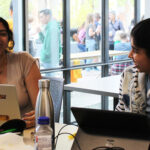
Organizing conferences worth the effort

Some of the the more than 400 attendees of the International Conference on Molecular Beam Epitaxy at the High Country Conference Center at Northern Arizona University. The conference was organized by faculty members in ASU’s Ira A. Fulton Schools of Engineering. Full-size photo available here.
Hosting events for engineering and science professionals events can boost careers, research, local economies and the university’s stature
The recent International Conference on Molecular Beam Epitaxy organized by Arizona State University faculty members proved to be a success on several fronts.
The event “showed why it is worth the effort for our faculty to get involved in organizing professional conferences,” said Yong-Hang Zhang, the associate dean for research in ASU’s Ira A. Futon Schools of Engineering, and a professor in the School of Electrical, Computer and Energy Engineering.
Zhang was the conference general chair. Shane Johnson, a research scientist with School of Electrical, Computer and Energy Engineering, served as the organization committee chair.
They worked together — beginning with a proposal four years ago — to bring the international meeting to the United States again after 12 years. It was held at the High Country Conference Center at Northern Arizona University in Flagstaff.
Molecular Beam Epitaxy, or MBE, is an advanced technology that uses an ultra-high-vacuum facility for making ultra-thin semiconductor crystalline materials with high precision at the monolayer level.
The semiconductor devices created by employing MBE as a manufacturing tool include diode lasers, photodetectors and electronic devices that are used in an array of technologies such as optical communication systems, smart phones, satellites, electronic displays and radar systems, as well as technologies used in scientific research.
Among about 430 conference attendees were many of the pioneers and current leaders in MBE research.
Many ASU faculty members attended the conference, and more than 25 ASU doctoral students and postdoctoral researchers made presentations on their work.
Some of the students had opportunities to meet directly with leading MBE experts and the pioneers in the field.
“That face-to-face contact can be very valuable to students,” Zhang said. “They can learn more than what they could by simply reading research papers.”
The conference was “a very big success judging by comments and messages we received from students and others who attended. They all said they got a lot of good things out of it,” Johnson said.
The gathering also drew some National Science Foundation (NSF) research program managers. Even though the conference site was more than 100 miles from ASU, two of the NSF program managers who attended took time to visit the university. They toured research facilities and met with about 10 faculty members.
Their visit demonstrated the potentially far-reaching positive impact of organizing and hosting such conferences, Zhang said.
“People who make decisions about awarding grants and where to establish research centers or collaborations get a chance to see ASU’s research strengths,” he said.
Such opportunities “shape new perceptions about ASU,” he said, creating positive impressions that will pay off in the future.
“The Fulton Schools of Engineering have invested tremendously in research in recent years, but few people are aware of this because ASU has grown and progressed so fast,” Zhang said.
Gaining attention through large conferences “helps our reputation catch up with our achievements,” he said.
Beyond the university in general, faculty members can raise their profile as leaders in their fields by organizing professional gatherings that draw attendees from throughout the country and the world.
“Doing that is a big way of contributing to your professional community, and it brings revenue into the local economy,” Zhang said. “It could be a very big step for junior faculty in advancing their careers. It is well worth the investment of extra effort and money.”
Zhang said the Fulton Schools research administration office he directs will guide and support faculty members who want to help organize conferences.
The success of the MBE conference could soon be repeated by an upcoming international computer security conference close to ASU in Scottsdale.
The ACM (Association for Computing Machinery) Conference on Computer and Communications Security is being chaired by Gail-Joon Ahn, a professor in the School of Computing, Informatics, and Decision Systems Engineering.
It’s first time the conference will be in Arizona. As the most prestigious gathering in the field, Ahn said, it is expected to bring more than 500 attendees to join “a forum of outstanding computer security researchers from all over the world.”
Ten other ASU engineering faculty members have roles in organizing and managing the conference: Dijiang Huang, Guoliang Xue, Nadya Bliss, Rida Bazzi, Adam Doupe, Huan Liu and Steve Yau in the School of Computing, Informatics, and Decision Systems Engineering; Yanchao Zhang and Junshan Zhang in the School of Electrical, Computing and Energy Engineering, and Werner Dahm in the School for Engineering of Matter, Transport and Energy.
“The importance of this conference is shown by the high-profile sponsors from the information technology industry,” he said.
Sponsors include Google, Hewlett Packard, SAP, CISCO, CAaNES (Computational Analysis & Network Enterprise Solutions), and ETRI (The Electronics and Telecommunications Research Institute), as well as the research divisions of Microsoft Research and IBM.
Lina Karam, a professor in the School of Electrical, Computer and Energy Engineering, is organizing the Institute of Electrical and Electronic Engineers (IEEE) International Conference on Image Processing to be held at the Phoenix Convention Center in September 2016. Karam will serve as general chair.
It is the premier conference in image and video processing, and attracts leaders in the field from academia and industry from many countries.
Several other ASU engineering faculty members will play key roles in the event. Professor Sethuraman Panchanathan, who is ASU’s senior vice president for Knowledge and Enterprise Development, will be plenary co-chair.
Associate professor David Frakes and assistant professor Pavan Turaga will be local arrangements co-chairs, and associate professor Baoxin Li will be a conference publication co-chair.
Media Contact
Joe Kullman, [email protected]
480-965-8122
Ira A. Fulton Schools of Engineering



































